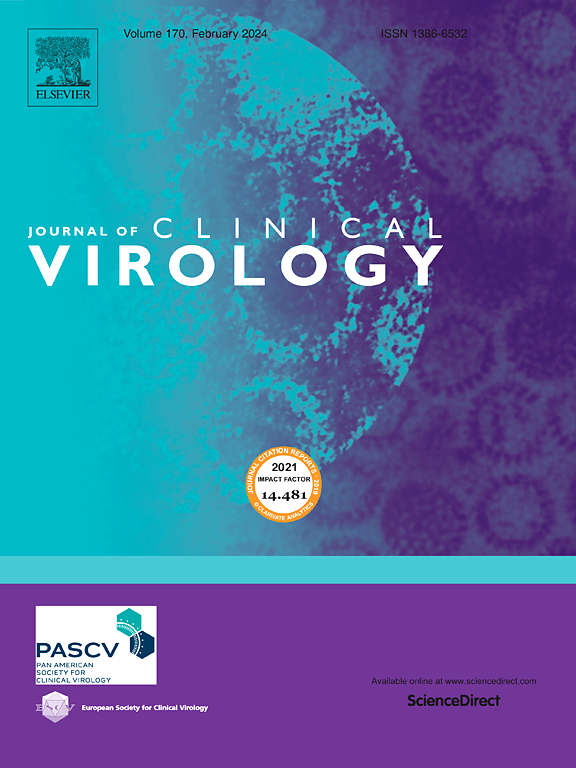副病毒 B19 仍是阿根廷妊娠期感染中被低估的病原体:通过对科尔多瓦有症状和无症状孕妇及新生儿的研究得出的启示。
IF 4
3区 医学
Q2 VIROLOGY
引用次数: 0
摘要
背景:妊娠期感染 Parvovirus B19(B19 V)会对胎儿造成不良影响。我们的目的是通过研究 B19 V 感染的病毒学和血清学标志物来描述临床和无症状孕产妇和新生儿病例的特征,并对阿根廷流行病毒的完整基因组进行测序:方法:根据孕产妇和/或胎儿-新生儿在妊娠期间因 B19 V 感染而出现的体征,纳入有症状的患者。对孕妇的分析分为及时诊断组(TD,在出现症状并怀疑感染时采集样本)或回顾诊断组(RD,产后立即采集样本),新生儿则在出生时进行分析。此外,还对无症状者的样本进行了分析。对2018年至2023年的存档血清样本进行了诊断测试(PCR/qPCR/血清学)和测序,并从病历中获取了临床数据:我们研究了 328 名有症状的患者,包括 185 名孕妇(73 名 TD 和 112 名 RD)和 143 名新生儿。其中,我们发现了27/328(8.2%)例阳性病例(B19V+):TD组12/73(16.4%)例,RD组6/112(5.4%)例,新生儿9/143(6.3%)例。在 77 对母婴中,有 8 例(10.4%)B19 V 感染和 6 例垂直传播。此外,在 26/310 例(8.4%)无症状患者中检测到 B19 V 型感染。系统发育分析确定基因型 1a 是阿根廷的一种流行菌株:我们的研究结果凸显了在阿根廷提高人们对 B19 V 感染的认识和加强诊断方法的必要性,以便更有效地识别和处理本地区的妊娠期 B19 V 感染。本文章由计算机程序翻译,如有差异,请以英文原文为准。
Parvovirus B19 remains an underestimated pathogen among infections during gestation in Argentina: Insights through the study of symptomatic and asymptomatic pregnant patients and newborns from Córdoba
Background
Parvovirus B19 (B19 V) infection during pregnancy can cause adverse fetal outcomes. Our aim was to characterize both clinical and asymptomatic maternal and neonatal cases by studying virological and serological markers of B19 V infection, and to sequence the complete genome of the circulating virus in Argentina.
Methods
Symptomatic patients were included based on maternal and/or fetal-neonatal signs attributable to B19 V infection during gestation. Pregnant patients were analyzed in either the timely diagnosis group (TD, samples obtained when symptoms were present and infection was suspected) or the retrospective diagnosis group (RD, samples collected immediately postpartum), and newborns were analyzed at birth. A sample of asymptomatic individuals was also analyzed. Diagnostic tests (PCR/qPCR/serology) and sequencing were performed on archived serum samples from 2018 to 2023, and clinical data were obtained from medical records.
Results
We studied 328 symptomatic patients, including 185 pregnant patients (73 TD and 112 RD) and 143 newborns. Among them, we identified 27/328 (8.2 %) positive cases (B19V+): 12/73 (16.4 %) in the TD group, 6/112 (5.4 %) in the RD group, and 9/143 (6.3 %) newborns. Within the 77 mother-newborn pairs included, there were 8 (10.4 %) B19 V infections and 6 cases of vertical transmission. Additionally, B19 V infection was detected in 26/310 (8.4 %) asymptomatic patients. Phylogenetic analysis identified genotype 1a as a circulating strain in Argentina.
Conclusions
Our findings highlight the need to raise awareness and enhance diagnostic approaches in Argentina to more effectively identify and manage B19 V infections during pregnancy in our region.
求助全文
通过发布文献求助,成功后即可免费获取论文全文。
去求助
来源期刊

Journal of Clinical Virology
医学-病毒学
CiteScore
22.70
自引率
1.10%
发文量
149
审稿时长
24 days
期刊介绍:
The Journal of Clinical Virology, an esteemed international publication, serves as the official journal for both the Pan American Society for Clinical Virology and The European Society for Clinical Virology. Dedicated to advancing the understanding of human virology in clinical settings, the Journal of Clinical Virology focuses on disseminating research papers and reviews pertaining to the clinical aspects of virology. Its scope encompasses articles discussing diagnostic methodologies and virus-induced clinical conditions, with an emphasis on practicality and relevance to clinical practice.
The journal publishes on topics that include:
• new diagnostic technologies
• nucleic acid amplification and serologic testing
• targeted and metagenomic next-generation sequencing
• emerging pandemic viral threats
• respiratory viruses
• transplant viruses
• chronic viral infections
• cancer-associated viruses
• gastrointestinal viruses
• central nervous system viruses
• one health (excludes animal health)
 求助内容:
求助内容: 应助结果提醒方式:
应助结果提醒方式:


